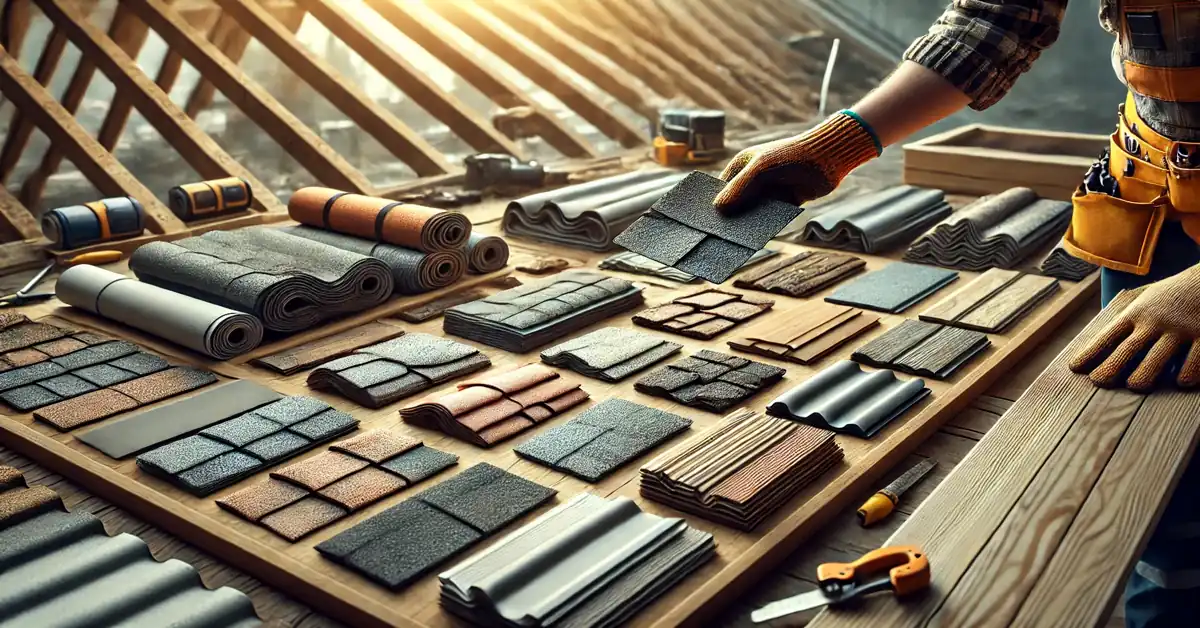When it comes to choosing roofing materials, homeowners have a wide range of options, each offering unique advantages in terms of durability, aesthetics, and energy efficiency. Selecting the right roofing material is essential not only for protecting your home but also for enhancing its appearance and potentially increasing its value. This guide explores the different types of roofing materials available today, along with their benefits and key considerations, to help you make an informed decision for your next roof installation.
1. Asphalt Shingles: A Popular Choice for Affordability and Versatility
Asphalt shingles are the most commonly used roofing material in North America, thanks to their affordability, durability, and ease of installation. They come in a variety of styles and colors, making it easy to find a look that complements your home’s exterior.
Benefits of Asphalt Shingles
- Cost-Effective: Asphalt shingles are among the most affordable roofing materials, making them a popular choice for homeowners on a budget.
- Easy to Install and Replace: Due to their lightweight nature, asphalt shingles are easy to install. In the event of damage, individual shingles can be replaced without much hassle.
- Weather Resistant: Asphalt shingles provide solid protection against wind, rain, and even hail. Many shingles come with additional features, such as algae resistance or impact resistance, for added durability.
Considerations
Asphalt shingles typically last 15 to 30 years, depending on the quality and the local climate. While they are cost-effective, they may not be as long-lasting as other roofing options. Homeowners looking for a basic yet reliable roofing solution will find that asphalt shingles offer great value for their price.
2. Metal Roofing: Long-Lasting and Eco-Friendly
Metal roofing has gained popularity in recent years due to its longevity, energy efficiency, and minimal maintenance requirements. Available in various styles, metal roofs can mimic the look of other materials, such as shingles or tiles, while offering superior durability.
Benefits of Metal Roofing
- Exceptional Longevity: Metal roofs can last 40 to 70 years or more, making them one of the longest-lasting roofing options. They are highly resistant to rust, corrosion, and weathering.
- Energy Efficiency: Metal roofing reflects sunlight, which helps reduce cooling costs during hot summer months. Many metal roofs are Energy Star-rated, contributing to lower energy bills.
- Environmentally Friendly: Most metal roofing materials are made from recycled metals, and they are fully recyclable at the end of their lifespan. This makes metal roofing a sustainable choice for eco-conscious homeowners.
Considerations
Metal roofing tends to have a higher upfront cost compared to asphalt shingles. However, its longevity and energy-saving benefits can make it a cost-effective choice over the long term. If you’re interested in investing in a durable, eco-friendly roofing solution, metal roofing could be the right fit.
3. Clay and Concrete Tiles: Elegant and Durable
Clay and concrete tiles are known for their distinctive, classic appearance, making them a popular choice for Mediterranean, Spanish, and Southwestern-style homes. These tiles are highly durable and offer excellent protection against the elements.
Benefits of Clay and Concrete Tiles
- Incredible Durability: Both clay and concrete tiles can last over 50 years, with clay tiles sometimes reaching a lifespan of 100 years. They are highly resistant to fire, pests, and rot.
- Energy Efficiency: The natural thermal properties of clay and concrete help regulate indoor temperatures, keeping your home cooler in the summer and warmer in the winter.
- Low Maintenance: Once installed, clay and concrete tiles require very little maintenance. They are resistant to weathering and retain their color over time, maintaining their aesthetic appeal for decades.
Considerations
Clay and concrete tiles are heavier than other roofing materials, so they require a strong structural framework for support. They are also among the more expensive roofing options. However, for homeowners looking for a distinctive and long-lasting roof, clay and concrete tiles are an excellent choice.
4. Wood Shingles and Shakes: A Natural, Timeless Appeal
Wood shingles and shakes offer a warm, natural appearance that complements rustic and historic homes. They are typically made from cedar, redwood, or pine, providing a renewable and biodegradable roofing option.
Benefits of Wood Shingles and Shakes
- Aesthetic Appeal: Wood shingles and shakes offer a unique, natural look that ages beautifully over time. They add character to the home and can be customized to achieve various finishes and styles.
- Good Insulation: Wood is a natural insulator, helping to improve the energy efficiency of your home. This can result in reduced heating and cooling costs.
- Environmentally Friendly: Sourced from sustainable forests, wood shingles and shakes are biodegradable and renewable, making them an eco-friendly choice.
Considerations
Wood roofing requires more maintenance than other materials, as it is susceptible to mold, rot, and insect damage. To prolong their lifespan, wood shingles and shakes should be treated and inspected regularly. They generally last 20 to 40 years, depending on the quality and level of maintenance.
5. Slate Roofing: Classic Beauty and Unmatched Durability
Slate is a premium roofing material known for its elegant, timeless appearance and unmatched durability. Often used on historic or high-end homes, slate roofs offer both aesthetic appeal and long-lasting performance.
Benefits of Slate Roofing
- Extraordinary Longevity: Slate roofs can last over 100 years, making them one of the most durable roofing options available. They are resistant to fire, mold, and weather damage, providing superior protection.
- Natural Appearance: Slate has a natural stone texture and color variation that adds elegance to any home. Its distinct look enhances curb appeal and contributes to a sense of luxury.
- Low Maintenance: Once installed, slate roofing requires minimal maintenance. It doesn’t rot or warp, and it can withstand extreme weather conditions.
Considerations
Slate is one of the most expensive roofing materials, both in terms of material cost and installation. It is also heavy, so the home’s structure must be able to support the weight. However, for homeowners seeking a roof with a classic look and an unparalleled lifespan, slate is an investment worth considering.
6. Synthetic Roofing: Affordable and Versatile
Synthetic roofing materials, such as rubber, plastic, and polymer, offer a versatile and affordable alternative to traditional roofing materials. These synthetic options are designed to mimic the look of slate, wood, or tile, providing a stylish and durable roofing solution.
Benefits of Synthetic Roofing
- Cost-Effective: Synthetic roofing materials are generally more affordable than natural alternatives like slate or wood. They offer a similar appearance at a fraction of the cost.
- Lightweight: Unlike heavy materials such as slate and clay, synthetic roofing is lightweight, making it suitable for most homes without additional structural support.
- Durability: Synthetic roofs are engineered to resist weathering, UV rays, and impact. Many are made from recycled materials, making them a sustainable and durable choice.
Considerations
While synthetic roofing offers versatility and cost savings, it may not last as long as natural materials. Most synthetic roofs have a lifespan of 20 to 50 years, depending on the material and quality. However, for homeowners looking for an affordable, low-maintenance roofing option, synthetic materials provide a wide range of choices.
Making the Right Choice
With so many options available, selecting the right roofing material can feel overwhelming. Consider your budget, the architectural style of your home, and the climate in your area. Consulting with a professional roofing contractor like Roofer.com can help you determine which material best suits your needs, ensuring a successful roof installation that provides lasting protection and enhances your home’s value.
Conclusion
Choosing the right roofing material is a crucial step in protecting your home and enhancing its curb appeal. Whether you prefer the affordability of asphalt shingles, the eco-friendliness of metal, or the timeless elegance of slate, there is a roofing material that meets your unique needs and preferences. By understanding the benefits and considerations of each option, you can make an informed decision that adds value to your home. For expert guidance and professional installation, work with a trusted roofing contractor like Roofer.com to ensure a roof that is beautiful, durable, and built to last.









